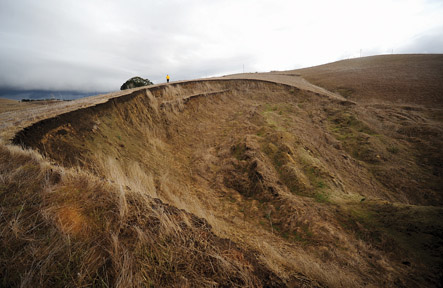
Water district varying levels to prevent landslides
A plan to vary the amount of water stored at San Justo Reservoir
throughout the year to curtail landslides caused by seepage, rather
than spending millions to repair the nearly 25-year-old facility,
seems to be working, local water officials say.
”
Everything is going as expected,
”
said Jeff Cattaneo, director of the San Benito County Water
District, which operates the Union Road facility that stores and
distributes water for agricultural use.
”
It looks like there were no issues at all with bringing the
reservoir elevation back up. It responded like we expected it
to.
”
Water district varying levels to prevent landslides
A plan to vary the amount of water stored at San Justo Reservoir throughout the year to curtail landslides caused by seepage, rather than spending millions to repair the nearly 25-year-old facility, seems to be working, local water officials say.
“Everything is going as expected,” said Jeff Cattaneo, director of the San Benito County Water District, which operates the Union Road facility that stores and distributes water for agricultural use. “It looks like there were no issues at all with bringing the reservoir elevation back up. It responded like we expected it to.”
The slow seepage of water has saturated the soil and caused landslides around the reservoir for years. The problem seemed to be exacerbated when the reservoir was kept at full capacity – nearly 500 feet – throughout the year. The constantly high water level kept the surrounding soil saturated, which led to the landslides.
Extra liner was added in recent years and return wells were added to reduce the amount of water from hillsides. The Bureau of Reclamation ordered the water district to lower the surface elevation of water in the reservoir to 485 feet to combat the seepage problem.
The water district has proposed operating the facility like it did in the early years: filling it to near capacity early in the season to maximize the agricultural supply and then drawing it down to at or below 485 feet during the growing season.
The hope is that alternating the water level throughout the year will alleviate the need for the estimated $3 million to $10 million it would take to repair the reservoir.
Meanwhile, San Justo remains closed to the public more than three years after invasive zebra mussels were discovered at the popular boating and fishing spot.
“It appears as if the mussel population has more or less stabilized as we are doing some things to help minimize the numbers,” Cattaneo said. “Last year we drew the reservoir down significantly to expose the mussels. The desiccation (drying out) process is the most effective way of killing them.”
Since the reservoir can’t be completely drained, the district hopes to gain approval to apply potash (potassium chloride) to the mussels to kill them, though Cattaneo said that won’t happen until the fall of 2012.
“San Justo will be closed for the foreseeable future,” he said. “Even after we implement the eradication effort, it will stay closed for some period of time while we monitor the results.”









